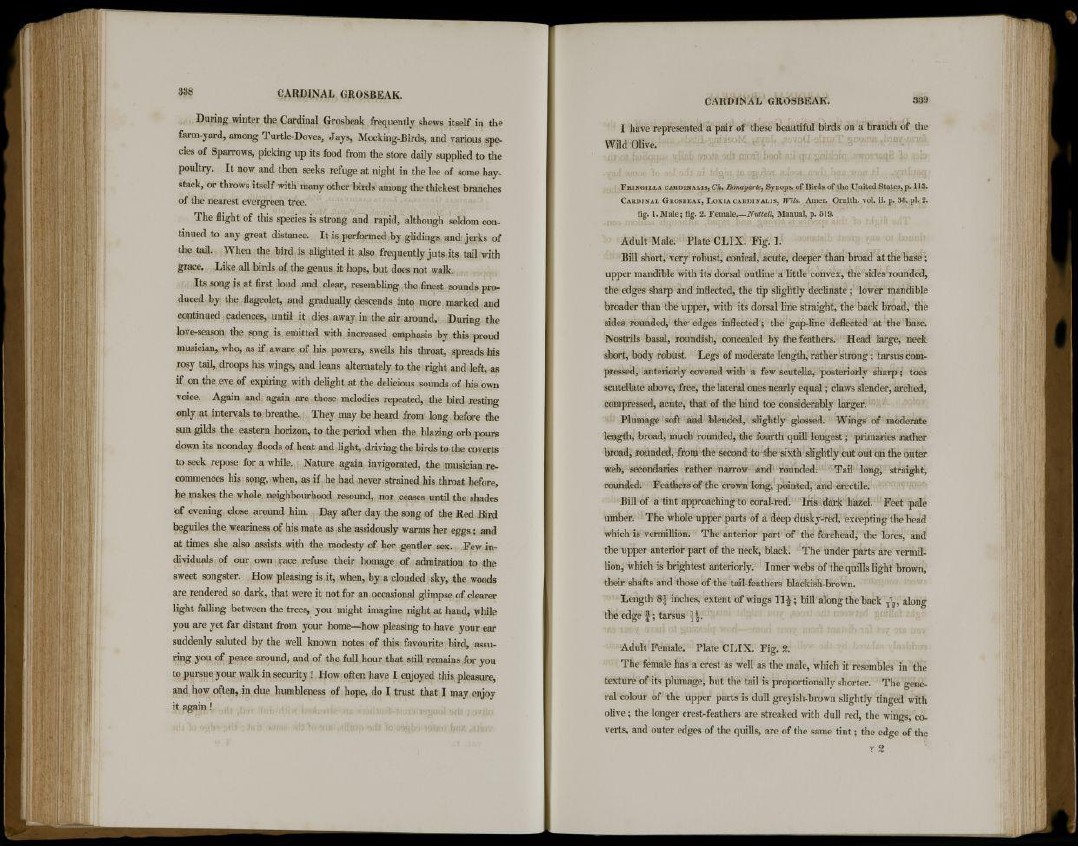
During winter the Cardinal Grosbeak frequently shews itself in the
farm-yard, among Turtle-Doves, Jays, Mocking-Birds, and various species
of Sparrows, picking up its food from the store daily supplied to the
poultry. It now and then seeks refuge at night in the lee of some haystack,
or throws itself with many other birds among the thickest branches
of the nearest evergreen tree.
The flight of this species is strong and rapid, although seldom continued
to any great distance. It is performed by glidings and jerks of
the tail. When the bird is alighted it also frequently juts its tail with
grace. Like all birds of the genus it hops, but does not walk.
Its song is at first loud and clear, resembling the finest sounds produced
by the flageolet, and gradually descends into more marked and
continued cadences, until it dies away in the air around. During the
love-season the song is emitted with increased emphasis by this proud
musician, who, as if aware of his powers, swells his throat, spreads his
rosy tail, droops his wings, and leans alternately to the right and left, as
if on the eve of expiring with delight at the delicious sounds of his own
voice. Again and again are those melodies repeated, the bird resting
only at intervals to breathe. They may be heard from long before the
sun gilds the eastern horizon, to the period when the blazing orb pours
down its noonday floods of heat and light, driving the birds to the coverts
to seek repose for a while. Nature again invigorated, the musician recommences
his song, when, as if he had never strained his throat before,
he makes the whole neighbourhood resound, nor ceases until the shades
of evening close around him. Day after day the song of the Red Bird
beguiles the weariness of his mate as she assidously warms her eggs ; and
at times she also assists with the modesty of her gentler sex. Few individuals
of our own race refuse their homage of admiration to the
sweet songster. How pleasing is it, when, by a clouded sky, the woods
are rendered so dark, that were it not for an occasional glimpse of clearer
light falling between the trees, you might imagine night at hand, while
you are yet far distant from your home—how pleasing to have your ear
suddenly saluted by the well known notes of this favourite bird, assuring
you of peace around, and of the full hour that still remains for you
to pursue your walk in security ! How often have I enjoyed this pleasure,
and how often, in due humbleness of hope, do I trust that I may enjoy
it again !
I have represented a pair of these beautiful birds on a branch of tin
Wild Olive.
FRINGILLA CARDINALIS, Ch. Bonaparte, Synops. of Birds of the United States, p. 113.
CARDINAL GROSHEAK, LOXIA CARDINALIS, Wils. Amer. Ornith. vol. ii. p. 38.pl. 2.
fig. 1. Male; fig. 2. Female Nuttall, Manual, p. 519.
Adult Male. Plate CLIX. Fig. 1.
Bill short, very robust, conical, acute, deeper than broad at the base;
upper mandible with its dorsal outline a little convex, the sides rounded,
the edges sharp and inflected, the tip slightly declínate ; lower mandible
broader than the upper, with its dorsal line straight, the back broad, the
sides rounded, the- edges inflected; the gap-line deflected at the base.
Nostrils basal, roundish, concealed by the feathers. Head large, neck
short, body robust. Legs of moderate length, rather strong ; tarsus compressed,
anteriorly covered with a few scutella, posteriorly sharp; toes
scutellate above, free, the lateral ones nearly equal; claws slender, arched,
compressed, acute, that of the hind toe considerably larger.
Plumage soft and blended, slightly glossed. Wings of moderate
length, broad, much rounded, the fourth quill longest; primaries rather
broad, rounded, from the second to the sixth slightly cut out on the outer
web, secondaries rather narrow and rounded. Tail long, straight,
rounded. Feathers of the crown long, pointed, and erectile.
Bill of a tint approaching to coral-red. Iris dark hazel. Feet pale
umber. The whole upper parts of a deep dusky-red, excepting the head
which is vermillion. The anterior part of the forehead, the lores, and
the upper anterior part of the neck, black. The under parts are vermillion,
which is brightest anteriorly. Inner webs of the quills light brown,
their shafts and those of the tail-feathers blackish-brown.
Length 8 | inches, extent of wings 11 bill along the back ft, along
the edge | ; tarsus
Adult Female. Plate CLIX. Fig. 2.
The female has a crest as well as the male, which it resembles in the
texture of its plumage, but the tail is proportionally shorter. The general
colour of the upper parts is dull greyish-brown slightly tinged with
olive; the longer crest-feathers are streaked with dull red, the wings, coverts,
and outer edges of the quills, are of the same tint; the edge of the